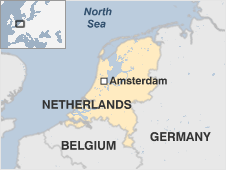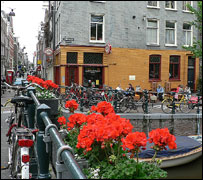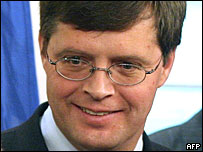 |
The Netherlands' name reflects its low-lying topographywith more than
a quarter of its total area under sea level.
Now a constitutional monarchythe country began its independent life as a republic in the 16th centurywhen the foundations were laid for it to become one of the world's foremost maritime trading nations.
Although traditionally among the keener advocates of the European UnionDutch voters echoed those in France by spurning the proposed EU
constitution in a 2005 referendum.
Overview
The Netherlands has produced many of the world's most famous artists from Rembrandt and Vermeer in the 17th century to Van Gogh in the 19th and Mondrian in the 20th. It attracts visitors from across the globe.

Amsterdam: Much of the city lies ator belowsea level
|
After a longstanding policy of neutrality between Europe's great powersthe
bitter experience of invasion and occupation during World War II led the Netherlands to become a leading supporter of international cooperation.
Almost 20% of the total area of the Netherlands is waterand much of the land has been reclaimed from the North Sea in efforts which date back to medieval times and have spawned an extensive system of dykes.
It is one of the world's most densely populated nations. As in many European countriesover-65s make up an increasing percentage of that populationleading to greater demands on the welfare system.
After two decades of strong growth and low unemploymentthe economy ran into more troubled waters as global tradein which the Netherlands is a major playerslowed in the early years of the new millennium.
There was concern that Dutch society's longstanding tradition of tolerance was under threat when homosexual anti-immigration politician Pim Fortuyn was assassinated in 2002.
Anxiety over increased racial tension has intensified further since the murder in 2004 of Theo Van Gogh who had made a controversial film on the position of women in Islamic society. A violent extremist later confessed and was jailed for life.
After Mr Van Gogh's killingthe government hardened its line on immigration and failed asylum seekers.
Facts
- Full name: The Kingdom of the Netherlands
- Population: 16.6 million (UN2009)
- Capital: Amsterdam; seat of government: the Hague
- Area: 41,864 sq km (16,164 sq miles)
- Major language: Dutch
- Major religion: Christianity
- Life expectancy: 78 years (men)82 years (women) (UN)
- Monetary unit: 1 euro = 100 cents
- Main exports: Metal manufacturingchemicalsfoodstuffs
- GNI per capita: US $50,150 (World Bank2008)
- Internet domain: .nl
- International dialling code: +31
Leaders
Head of state: Queen Beatrix
Prime minister: Jan Peter Balkenende
Queen Beatrix appointed Jan Peter Balkenende as head of a three-party centrist coalition in February 2007three months after general elections in November 2006.

Prime Minister Balkenende's former coalition sought to curb spending
|
Mr Balkenende's Christian Democrats govern with the Labour Party and the Christian Union.
He was forced to call early elections after his centre-right coalition collapsed in June 2006 in a row over immigration policy.
It was made up of the Christian Democratsthe free-market People's Party for Freedom and Democracy (VVD) and the small centrist party Democrats-66.
The new government is expected to slow the pace of economic reform; its predecessor had introduced austerity measures to tackle unemploymentslow growth and a budget deficit. Spending cuts and welfare reforms sparked street protests.
It is expected to take a softer line on immigration and has announced an
amnesty for many failed asylum seekers.
The administration includes the first Muslims to attain cabinet rank.
Mr Balkenende was 46 when he first became prime minister in 2002. He had never held cabinet office before and became leader of his party in parliament only in 2001. He holds a degree in economics and law and is a devout Calvinist.
Media
The Dutch approach to public broadcasting is unique. Programmes are made by a variety of groupssome reflecting political or religious currents in societyothers representing interest groups. These organisations are allocated airtime on TV and radioin line with the number of members they have.
Public radio and TV channels face stiff competition from commercial stationswhich mushroomed after a 1988 law lifted the ban on commercial broadcasting.
The TV market is very competitive. Viewers have access to a wide range of domestic and foreign channelsthanks mainly to one of the highest cable take-up rates in Europe. Every province has at least one local public TV channel. The three national public TV stations enjoy high audience shares.
Freedom of the press is guaranteed by the constitutionas is free speech. Newspaper ownership is highly concentrated. Most titles are broadsheets; Dutch readers have not developed a taste for tabloid sensationalism.
The press
- Algemeen Dagblad - nationaldaily
- NRC Handelsblad - nationaldaily
- De Telegraaf - nationaldaily
- De Volkskrant - nationaldaily
- Trouw - nationaldaily
- Het Parool - Amsterdam daily
- Het Financieele Dagblad - financial daily
- Elsevier - news weekly
- Vrij Nederland - news weekly
Television
- NOS - oversees the country's three national public networks
- BVN TV - publicfor Dutch-speakers abroad
- RTL - commercialoperates RTL4RTL5RTL7 and RTL8
- SBS - commercialoperates SBS6Net5 and Veronica
Radio
- NOS - oversees public radio stationsincluding news and information station Radio 1music network Radio 2pop station 3FMcultural station Radio 4
- Radio Netherlands - international broadcasterlanguage services include English
- Sky Radio - popular commercial FM stationcontinuous music
- Radio 538 - popular commercial FM stationpop and dance music
- BNR Nieuwsradio - commercialnews
News agency
-
Algemeen Nederlands Persbureau (ANP)
AFRICA | ASIA-PACIFIC | AMERICAS | EUROPE | MIDDLEEAST | SOUTHASIA
Mauritania Mauritius Morocco Mozambique Namibia Niger Nigeria Republic-of-congo Rwanda Sao-tome-and-principe Senegal Seychelles Sierra-leone Somalia South-africa Sudan Swaziland Tanzania The-gambia Togo Tunisia Uganda zambia Zimbabwe Australia Brunei Burma Cambodia China East-timor Fiji Indonesia Japan Kazakhstan Kiribati Kyrgyzstan Laos Malaysia Marshall-islands Micronesia Mongolia Nauru New-zealand North-korea Palau Papua-new-guinea Samoa Singapore Solomon-islands South-korea Taiwan Tajikistan Thailand The-philippines Tonga Turkmenistan Tuvalu Uzbekistan Vanuatu Vietnam Antigua-and-barbuda Argentina Bahamas Barbados Belize Bolivia Brazil Canada Chile Colombia Costa-rica Cuba Dominica Dominican-republic Ecuador El-salvador Grenada Guatemala GuyanaHaiti Honduras Jamaica Mexico Nicaragua Panama Paraguay Peru St-kitts-and-nevis St-lucia St-vincent-and-the-grenadines Suriname Trinidad-and-tobago United-states-of-america Uruguay Venezuela Albania Andorra Armenia Austria Azerbaijan Belarus Belgium Bosnia-hercegovina Bulgaria Croatia Cyprus Czech-republic Denmark Estonia Finland France Georgia Germany Greece Hungary Iceland Ireland Italy Latvia Liechtenstein Lithuania Luxembourg Macedonia Malta Moldova Monaco Montenegro Norway Poland Portugal Russia San-marino Serbia Slovakia Slovenia Spain Sweden Switzerland The-netherlands Turkey Ukraine United-kingdom Vatican Algeria Egypt Iran Iraq Israel-and-palestinian-territories Jordan Kuwait Lebanon Libya Mauritania Oman Saudi-arabia Sudan Syria Tunisia United-arab-emirates Yemen Afghanistan Bangladesh Bhutan India Nepal Pakistan Sri-Lanka The-Maldives

